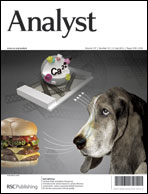Highly sensitive, selective, and rapid fluorescence Hg2+ sensor based on DNA duplexes of poly(dT) and graphene oxide
Abstract
Coupling T base with Hg2+ to form stable T–Hg2+–T complexes represents a new direction in detection of Hg2+. Here a graphene oxide (GO)-based fluorescence Hg2+ analysis using DNA duplexes of poly(dT) that allows rapid, sensitive, and selective detection is first reported. The Hg2+-induced T15–(Hg2+)n–T15 duplexes make T15 unable to hybridize with its complementary A15 labelled with 6′-carboxyfluorescein (FAM-A15), which has low fluorescence in the presence of GO. On the contrary, when T15 hybridizes with FAM-A15 to form


 Please wait while we load your content...
Please wait while we load your content...